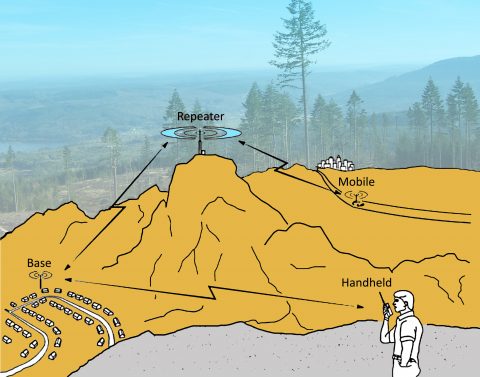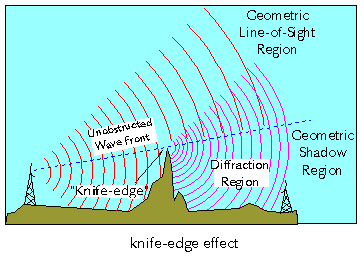
As can be seen from this image the ability to communicate over significant distances, and to overcome local obstacles to a sufficient response, is accomplished with the proper system design. The radio service in which this installation is licensed is the General Mobile Radio Service (GMRS) which began as the "Class A Citizens Radio Service" with roots dating back to the late 1940s & early 50s. Bearing little resemblance to the 27 MHz "Class D CB Radio Service", so popular (and frustrating) in the 1970s & 80s, the GMRS is operated with modern UHF-FM communications equipment with performance generally identical to current Police, Fire and other First-responder systems, yet still permitting "family-style" operation.
Base, hand-held, and mobile units can communicate directly between individual units, when the local need exists, BUT they also have the ability to conduct wide-area communications by connecting THROUGH mountain-top repeaters. In fact, this is the typical mode of communication as it helps to regularly connect all Oly-Comm members thus developing their two-way radio skills and sense of community.
While highly valuable in UHF operations, repeaters are not the only way for communication to occur, even in mountainous or varied terrain. "Simplex", "Talk-around" or "Direct" are modes of radio communication that can still occur when repeaters are being utilized for wide-area comms or are heavily congested. Terrain blockage is real, but does not always spell the end of UHF communication. A phenomenon known as "Knife-edge Refraction" also has impact upon the distances over which radio communication occurs. Here is some data, gleaned from other reference sites on the web, to help present the concept.
The Knife-edge Effect
In electromagnetic wave propagation, a redirection by diffraction of a portion of the incident radiation that strikes a well-defined obstacle such as a mountain range or the edge of a building. (188) Note: The knife-edge effect is explained by Huygens' principle, which states that a well-defined obstruction to an electromagnetic wave acts as a secondary source, and creates a new wavefront. This new wavefront propagates into the geometric shadow area of the obstacle.